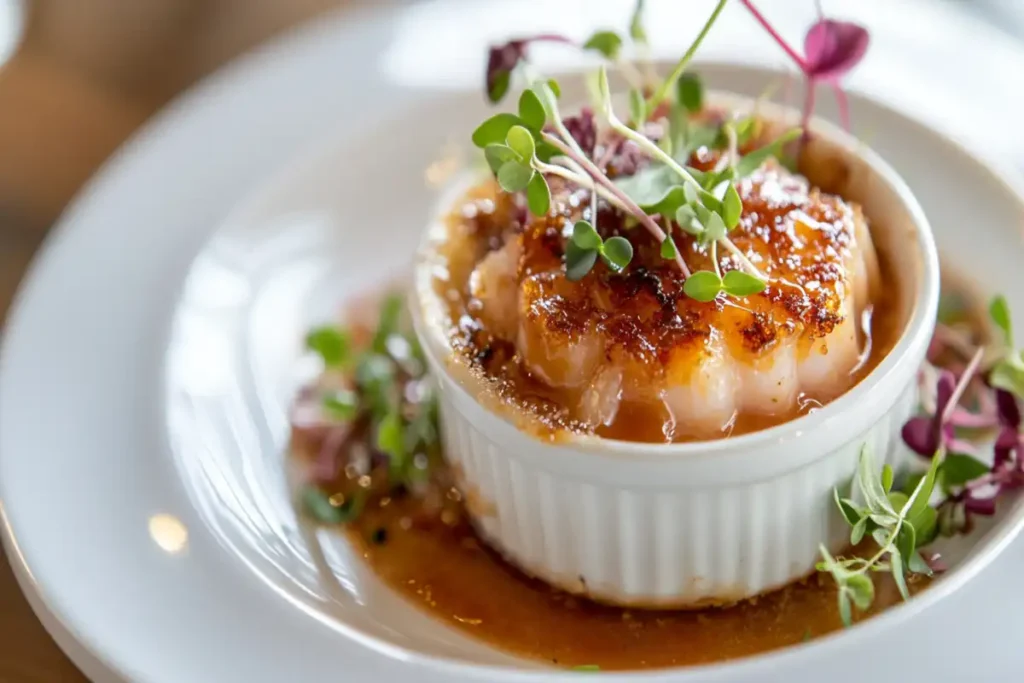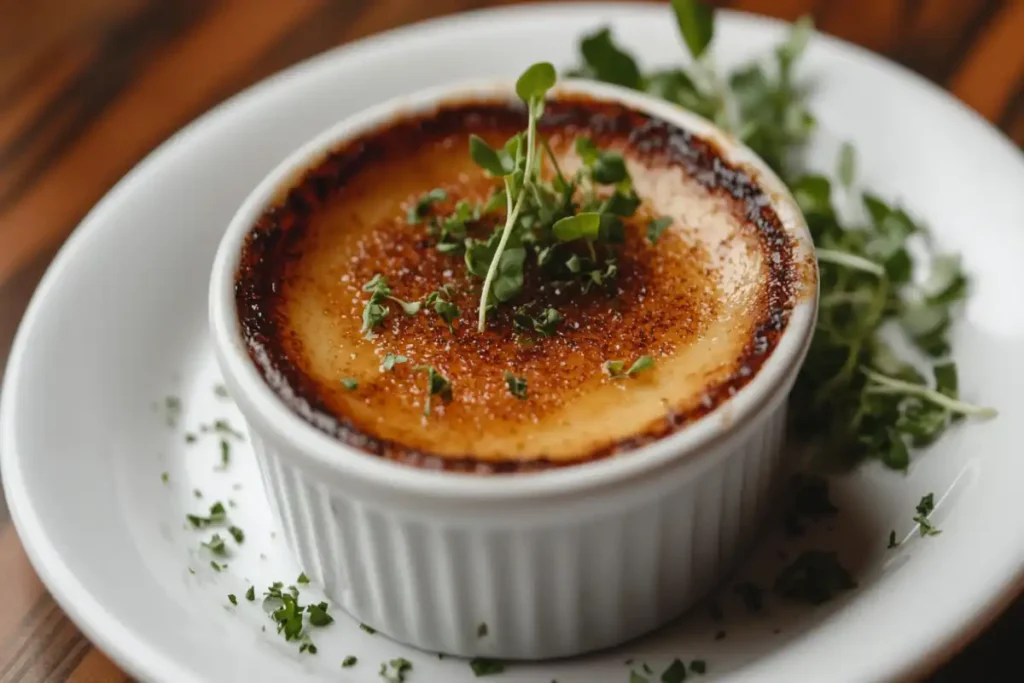Crème brûlée is the epitome of French indulgence—a perfect balance of silky custard and crunchy, caramelized sugar that crackles with every spoonful. If you’ve ever wondered what the secret to crème brûlée is, you’re not alone. Whether you’re a home cook or an aspiring pastry chef, mastering this dessert involves more than just following a recipe. It’s about understanding the intricate techniques and the science behind the custard, the right way to caramelize the sugar, and, most importantly, how to achieve that signature velvety texture.
In this article, we’ll dive deep into what makes crème brûlée so irresistible, from choosing the right ingredients to perfecting your cooking techniques. Plus, we’ll uncover a few tips and tricks that might just make you the crème brûlée expert at your next dinner party.

What Makes it So Special?
The Role of the Caramelized Sugar
One of the key elements in what makes crème brûlée so special is the sugar topping. When it’s done right, the sugar forms a delicate, crunchy shell that contrasts perfectly with the smooth custard. This glossy, golden layer is not only a visual delight but also a critical part of the experience. It’s that first crack you make with your spoon that makes crème brûlée unforgettable.
Crab crème brûlée is a delightful twist on the classic dessert, combining the rich, creamy custard with the sweet, delicate flavor of fresh crab for an unforgettable savory-sweet experience.
The Simplicity of Ingredients, The Complexity of Technique
When you look at the ingredients for crème brûlée, they may seem simple enough—heavy cream, egg yolks, vanilla, sugar, and salt. However, the true challenge comes in creating the ideal balance between these ingredients. The rich cream and egg yolks form the base of the custard, but the vanilla is what gives it that signature flavor. Finding the perfect ratio between these elements, while avoiding curdling or overcooking, is crucial to making perfect crème brûlée.
Why the Right Equipment Matters
Another critical factor in achieving the perfect crème brûlée is the use of the right equipment. While you can make crème brûlée in any oven, the right ramekins, a good torch, and a bain-marie setup can make a world of difference. For example, ramekins with straight sides will help the custard cook evenly. A shallow dish also ensures that the custard cooks gently and doesn’t form bubbles or cracks.
Additionally, using a kitchen torch to caramelize the sugar gives you more control than an oven broiler. It’s the key to achieving that thin, even layer of caramelized sugar that’s so distinctive of crème brûlée.
In conclusion, the secret to making crème brûlée isn’t just about having the best ingredients. It’s also about using the right techniques and the right tools. But don’t worry if you’re just getting started; with a little patience and practice, you’ll soon unlock the full potential of this elegant dessert.
In the next part of the article, we’ll dive deeper into the essential ingredients that make crème brûlée such a beloved dessert. We’ll discuss how each element contributes to the final dish and how to choose the best ingredients to elevate your recipe. Stay tuned!
The Essential Ingredients for Perfect Crème Brûlée
What Are the Key Ingredients in Crème Brûlée?
If you’ve ever wondered what the secret to crème brûlée is, it’s time to look at the ingredients. Crème brûlée is deceptively simple in terms of what goes into it—just a handful of basic ingredients—but it’s their careful selection and combination that create the magic. Let’s take a closer look at each ingredient and its role in this timeless dessert.
Heavy Cream – The Heart of the Custard
The heavy cream in crème brûlée is what gives the dessert its rich, velvety texture. Unlike other custard-based desserts, which might use milk, crème brûlée relies on the luxurious richness of heavy cream to create that indulgent mouthfeel. The fat content in cream helps to create a smooth, creamy custard, and it also contributes to the stability of the dessert when baked.
Egg Yolks – The Secret to the Custard’s Texture
Egg yolks are another crucial component in the secret to crème brûlée. They provide the custard with its silky texture and are the reason for its rich, golden color. Egg yolks also act as a natural thickening agent. When gently heated, they help the cream to set into a creamy consistency that doesn’t become too stiff or runny.
It’s important not to overcook the egg yolks, as this will cause the custard to curdle. The key here is to whisk the eggs with the sugar and then slowly incorporate them into the hot cream, tempering them gradually to prevent scrambling.
Vanilla – A Flavor That Makes a Difference
Vanilla is the classic flavor in crème brûlée, and it’s one of the elements that gives this dessert its unique, comforting appeal. The quality of your vanilla makes a big difference here. You can choose to use vanilla beans, which impart a more robust, complex flavor, or pure vanilla extract, which is more convenient and still produces a beautiful taste. If you opt for vanilla beans, don’t forget to scrape the seeds out and infuse them in the cream as it heats.
While it might seem like a small detail, using the highest-quality vanilla you can find will elevate the flavor profile of your crème brûlée. After all, it’s not just about the custard; the aroma of the vanilla adds depth and complexity to the dessert.
Sugar – Sweetening the Deal
Sugar is an essential part of crème brûlée—not only does it sweeten the custard, but it also plays a critical role in the topping. Granulated white sugar is typically used for the caramelized layer, while superfine sugar works better in the custard because it dissolves more easily.
For the caramelized sugar topping, using a fine, even layer of sugar ensures that the topping melts and browns evenly when you apply heat. While granulated sugar is the go-to choice, some bakers prefer using turbinado sugar for a deeper, more complex caramel flavor. The secret is to use just enough sugar to form a crisp, satisfying shell, without overwhelming the dessert.
Salt – The Subtle Balancing Act
While salt isn’t the first ingredient that comes to mind when thinking about crème brûlée, it plays a critical role in balancing the sweetness of the dessert. A pinch of salt enhances the richness of the custard and helps to bring out the natural flavors of the cream and vanilla. Without it, the dessert might taste overly sweet or one-dimensional.
The salt should be added sparingly—just a small pinch is enough. It’s not meant to be a dominant flavor but rather a subtle accent that enhances the overall taste of the crème brûlée.
Choosing the Right Ingredients for the Best Crème Brûlée
Now that we’ve explored the main ingredients, let’s talk about how to select the best ones. The quality of your ingredients will determine the final outcome of your crème brûlée, so here are some tips to help you choose wisely:
- Opt for full-fat cream: The cream is the foundation of your custard, so don’t skimp on the fat content. Choose the richest cream you can find for the best results.
- Fresh egg yolks: Fresh eggs will give the custard a smooth texture and prevent any off flavors from affecting your dessert.
- Use high-quality vanilla: Whether you choose beans or extract, the quality of vanilla will make a noticeable difference in flavor. Fresh vanilla beans are ideal for a richer taste.
- Don’t go overboard with sugar: For the caramelized topping, a thin layer of sugar is all you need. Be sure to use superfine sugar for the custard and granulated or turbinado sugar for the caramelized top.
By selecting the best ingredients and paying attention to their quality, you’ll be well on your way to mastering the secret to crème brûlée.
Mastering the Technique – How to Make the Perfect Crème Brûlée
What’s the Secret to Cooking Crème Brûlée Perfectly?
Now that you’ve selected the finest ingredients for your crème brûlée, the next step is to combine them in a way that brings out the best qualities of each element. The secret to crème brûlée isn’t just in the ingredients themselves, but in the method of preparation and cooking. With a few precise steps and a careful approach, you’ll achieve that perfect custard consistency and glorious caramelized topping.
Preparing the Custard Base
The first step in creating the perfect crème brûlée is making the custard base. This part requires patience and a steady hand, but don’t worry—once you know the process, it’s simple and rewarding.
- Heat the Cream: Begin by heating the heavy cream in a saucepan over medium heat. Add your vanilla bean or vanilla extract to the cream to infuse the flavor. If you’re using a vanilla bean, slice it open, scrape the seeds into the cream, and add the pod as well. Heat the cream just until it starts to steam—don’t bring it to a full boil, as this can cause the cream to curdle.
- Whisk the Egg Yolks and Sugar: While the cream is heating, whisk together the egg yolks, sugar, and a pinch of salt in a separate bowl. Whisk until the mixture is pale and slightly thickened. This step is important because it helps create the smooth texture of the custard once it’s cooked.
- Temper the Eggs: Once the cream is hot, it’s time to combine it with the eggs. This must be done slowly to avoid curdling the eggs. To do this, pour a small amount of the hot cream into the egg mixture while whisking constantly. This is called tempering. Gradually add the rest of the cream, continuing to whisk to prevent the eggs from scrambling. Once fully combined, you’ll have a smooth custard mixture.
- Strain the Custard: To ensure a perfectly smooth custard, strain the mixture through a fine mesh sieve into another bowl. This will remove any bits of cooked egg or impurities, leaving you with a silky custard base.
Baking Crème Brûlée in a Bain-Marie
The next critical step in perfecting your crème brûlée is baking it in a bain-marie (water bath). This method of cooking helps the custard set evenly without overheating, which could cause curdling.
- Prepare Your Ramekins: Pour the custard mixture into individual ramekins. Make sure each ramekin is filled to the same level to ensure even cooking. If you’re using larger ramekins, adjust the cooking time accordingly.
- Create the Water Bath: Place the ramekins in a deep baking dish and fill the dish with hot water. The water should come up to about halfway up the sides of the ramekins. This gentle, indirect heat will ensure that your custard cooks evenly, resulting in a silky texture.
- Bake at Low Temperature: Place the baking dish in a preheated oven at 325°F (165°C). Bake the custards for about 40-45 minutes, or until the custard is just set around the edges but still slightly wobbly in the center. You’ll know it’s done when you gently shake the ramekin and the custard moves like jelly, but doesn’t ripple too much.
The Cooling Process
After baking, allow your crème brûlée to cool in the water bath for about 15 minutes before removing them. Once they’ve cooled to room temperature, place the ramekins in the refrigerator for at least 2 hours, or ideally overnight. Chilling the custard allows the flavors to develop and ensures that the custard has the correct consistency.
This is also a good time to prep the caramelized sugar topping, which will come next.
Caramelizing the Sugar – The Final Touch

The key to that signature crack of crème brûlée lies in the sugar topping. Achieving a perfectly crisp, golden layer of caramelized sugar takes practice, but the technique is simple.
- Sprinkle a Thin Layer of Sugar: After your crème brûlée has chilled, sprinkle an even layer of superfine sugar on top of the custard. The sugar should be finely ground so that it melts evenly and doesn’t create a thick, uneven crust.
- Use a Kitchen Torch: Now comes the fun part! Using a kitchen torch, carefully melt the sugar by moving the flame across the surface of the custard. Hold the torch about 2 inches above the sugar and move it slowly and evenly across the surface. The sugar will melt and bubble, eventually turning a deep golden brown. This caramelization should be quick—don’t hold the flame too long in one spot, as the sugar will burn.
If you don’t have a kitchen torch, you can also use an oven broiler to caramelize the sugar. Place the ramekins under the broiler for about 1-2 minutes, watching them carefully so they don’t burn. Broiling works best when the custard is already cold, as it helps maintain the delicate texture.
Let the Sugar Set
Once the sugar is caramelized, let the crème brûlée sit for a minute or two to allow the sugar to harden. The result will be a perfectly crispy, crackling top that provides a satisfying contrast to the smooth custard underneath.
The Final Touches
Before serving, garnish your crème brûlée with fresh berries, a sprig of mint, or even a dusting of powdered sugar if you prefer. Serve it with a small spoon to allow guests to enjoy the delicate texture and rich flavor.
FAQs about Crème Brûlée
What is the secret to crème brûlée?
The secret to crème brûlée lies in the careful balance of rich ingredients (like heavy cream, egg yolks, and vanilla), combined with the right cooking technique. The bain-marie (water bath) baking method ensures even cooking, while the caramelized sugar topping provides the signature crack. Achieving the perfect texture and flavor depends on patience, attention to detail, and using high-quality ingredients.
How do you get the top of crème brûlée crunchy?
To get the perfect crunchy top, sprinkle a thin, even layer of superfine sugar on the cooled custard. Then, use a kitchen torch to gently melt and caramelize the sugar. The goal is to create a golden, crispy layer without burning the sugar or affecting the delicate custard beneath. Alternatively, you can use an oven broiler for the same effect.
Can you make crème brûlée ahead of time?
Yes, crème brûlée can be made in advance. After baking and cooling the custard, refrigerate it for at least 2 hours (or overnight). You should caramelize the sugar layer just before serving, so the topping remains fresh and crunchy. Making crème brûlée ahead of time not only saves you time but also enhances the flavor as it allows the custard to fully set.
How do you know when crème brûlée is done baking?
Crème brûlée is done when the custard is set around the edges but still slightly wobbly in the center. To test it, gently shake the ramekin—if the custard moves like jelly but doesn’t ripple too much, it’s ready. Overbaking can cause the custard to curdle, so it’s important to bake at a low temperature (around 325°F or 165°C) and monitor it closely.
Can you use milk instead of cream for crème brûlée?
While it’s possible to use milk instead of heavy cream, it will result in a lighter, less rich texture. The key to crème brûlée’s signature richness comes from the high-fat cream, which contributes to the custard’s creamy texture. Using milk may produce a custard that is not as smooth and indulgent.
What kind of sugar do you use for the brûlée top?
For the caramelized sugar topping, it’s best to use superfine sugar because it dissolves easily and creates a smooth, even layer. You can also use granulated or turbinado sugar, but superfine sugar gives the best results.
Conclusion
There you have it—the secret to crème brûlée is as much about the technique as it is about the ingredients. By choosing the finest ingredients, following the proper steps, and practicing the art of caramelizing sugar, you can master this iconic French dessert. From creating a silky-smooth custard base to achieving that satisfying golden crust, each step contributes to the final, melt-in-your-mouth experience.

